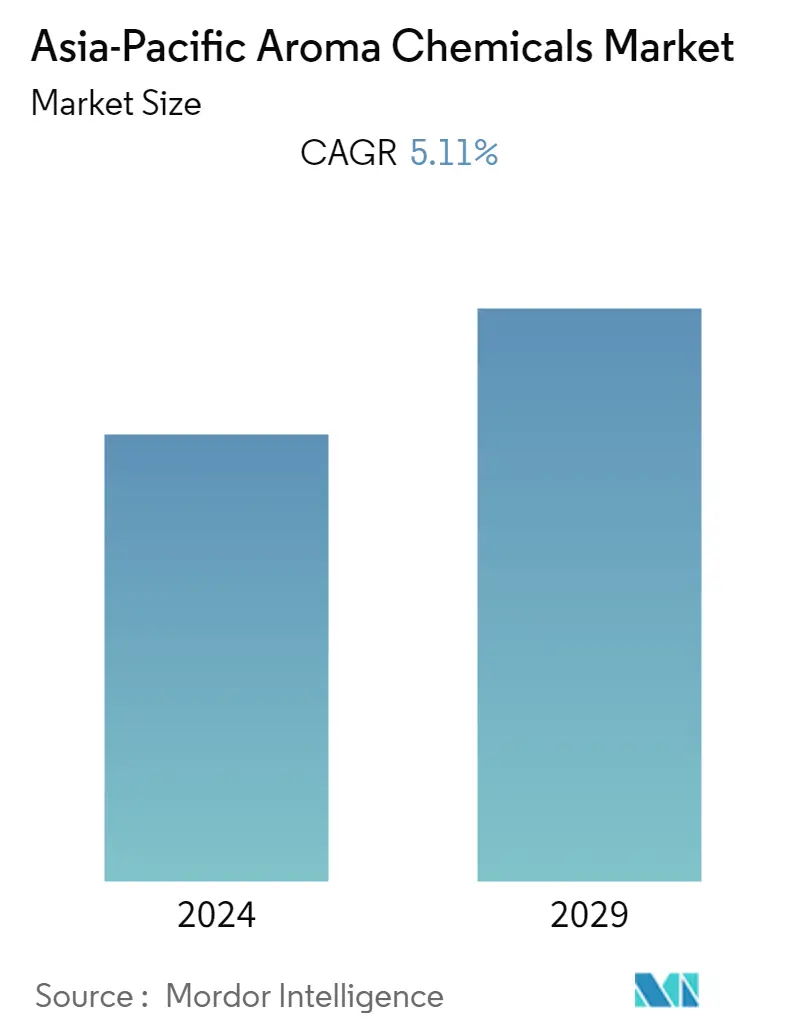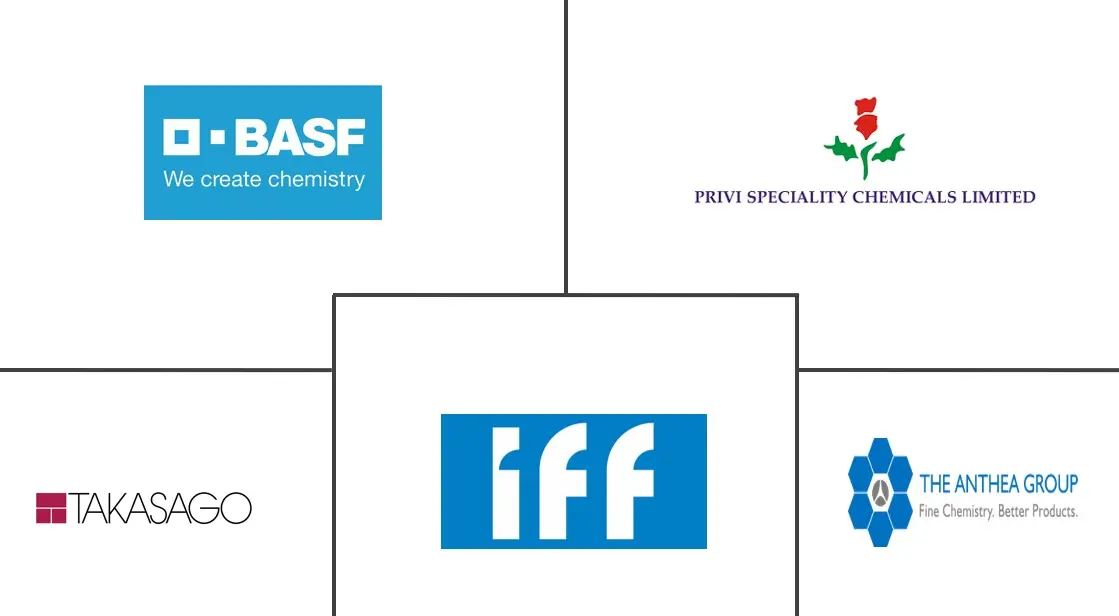Market Size of Asia-Pacific Aroma Chemicals Industry

| Study Period | 2019 - 2029 |
| Base Year For Estimation | 2023 |
| Forecast Data Period | 2024 - 2029 |
| Historical Data Period | 2019 - 2022 |
| CAGR | 5.11 % |
| Market Concentration | Low |
Major Players
*Disclaimer: Major Players sorted in no particular order |
Asia-Pacific Aroma Chemicals Market Analysis
The Asia-Pacific aroma chemicals market size is estimated to reach USD 1.93 billion by the end of this year and is projected to reach USD 2.48 billion in the next five years, registering a CAGR of 5.11% during the forecast period.
Unlike various other chemicals, the demand for aroma chemicals witnessed positive growth in certain segments due to the COVID-19 outbreak, owing to the change in lifestyle, which necessitated an increase in hand washing frequencies and better hygiene in general, which led to increased usage of soaps, hand washes, and other products. However, nationwide lockdowns in several countries led to several production and overall operations challenges.
- One of the major factors driving the market studied is the growing demand for flavors and fragrances in the food and beverage industry owing to the increased consumption of packaged and processed foods.
- Conversely, high research and development costs for aroma chemicals hinder the market's growth.
- Advancement in technology for the extraction of aroma chemicals is expected to offer various opportunities for market growth over the forecast period.
- In the Asia-Pacific region, China is expected to dominate the market in terms of demand owing to the vivid presence and continuous expansion of major end-user industries.
Asia-Pacific Aroma Chemicals Industry Segmentation
Aroma chemicals are highly volatile, complex aromatic compounds known for enhancing the flavor or fragrance of the formulations into which they are infused.
The Aromatic Chemicals market is segmented by type, application, and geography. The market is segmented by terpenes, benzenoids, musk chemicals, and other types (esters, ketones, etc.). The market is segmented by application into soap and detergents, cosmetics and toiletries, fine fragrances, household products, food and beverage, and other applications (textiles, tobacco, candles, etc.). The report also covers the market size and forecasts in 5 countries across the Asia-Pacific region. For each segment, market sizing and forecasts are provided on the basis of value (USD).
| Type | |
| Terpenes | |
| Benzenoids | |
| Musk Chemicals | |
| Other Types (Esters, Ketones, etc.) |
| Application | |
| Soap and Detergents | |
| Cosmetics and Toileteries | |
| Fine Fragrances | |
| Household Products | |
| Food and Beverage | |
| Other Applications (Textile, Tobacco, Candles, etc.) |
| Geography | |
| China | |
| India | |
| Japan | |
| South Korea | |
| ASEAN Countries | |
| Rest of Asia-Pacific |
Asia-Pacific Aroma Chemicals Market Size Summary
The Asia-Pacific aroma chemicals market is experiencing a positive trajectory, driven by the increasing demand for flavors and fragrances, particularly in the food and beverage sector. This demand is fueled by the rising consumption of packaged and processed foods, especially in developing economies like China and India. The shift towards natural aroma chemicals is notable, as consumers increasingly prefer nutritional and healthy options. The region's market is characterized by the robust expansion of the food processing industry, particularly in China, which is a major consumer of food and beverages. India's food industry is also on a growth path, supported by favorable government policies and investments in food processing, further boosting the demand for aroma chemicals.
In addition to the food and beverage industry, aroma chemicals are widely used in cosmetics, personal care, soaps, and detergents, enhancing product fragrance and appeal. China, being the second-largest consumer of cosmetic products globally, sees significant growth in its beauty and personal care market, influenced by e-commerce and rising disposable incomes. The fragrance market in China is expanding, driven by youth consumer trends and luxury product popularity. The soap and detergent market in China is also evolving, with innovations aimed at environmentally friendly production processes. The market is fragmented, with key players like BASF SE, Takasago International Corporation, and International Flavors & Fragrances Inc. actively expanding their capacities to meet the growing demand.
Asia-Pacific Aroma Chemicals Market Size - Table of Contents
-
1. MARKET DYNAMICS
-
1.1 Market Drivers
-
1.1.1 Increasing Usage in the Food and Beverage Industry
-
1.1.2 Growing Demand for Fine Fragrances
-
1.1.3 Other Drivers
-
-
1.2 Market Restraints
-
1.2.1 High Research and Development Costs
-
1.2.2 Other Restraints
-
-
1.3 Industry Value Chain Analysis
-
1.4 Porter's Five Forces Analysis
-
1.4.1 Bargaining Power of Buyers
-
1.4.2 Bargaining Power of Suppliers
-
1.4.3 Threat of New Entrants
-
1.4.4 Threat of Substitute Products
-
1.4.5 Degree of Competition
-
-
-
2. MARKET SEGMENTATION (Market Size in Value)
-
2.1 Type
-
2.1.1 Terpenes
-
2.1.2 Benzenoids
-
2.1.3 Musk Chemicals
-
2.1.4 Other Types (Esters, Ketones, etc.)
-
-
2.2 Application
-
2.2.1 Soap and Detergents
-
2.2.2 Cosmetics and Toileteries
-
2.2.3 Fine Fragrances
-
2.2.4 Household Products
-
2.2.5 Food and Beverage
-
2.2.6 Other Applications (Textile, Tobacco, Candles, etc.)
-
-
2.3 Geography
-
2.3.1 China
-
2.3.2 India
-
2.3.3 Japan
-
2.3.4 South Korea
-
2.3.5 ASEAN Countries
-
2.3.6 Rest of Asia-Pacific
-
-
Asia-Pacific Aroma Chemicals Market Size FAQs
What is the current Asia-Pacific Aroma Chemicals Market size?
The Asia-Pacific Aroma Chemicals Market is projected to register a CAGR of 5.11% during the forecast period (2024-2029)
Who are the key players in Asia-Pacific Aroma Chemicals Market?
BASF SE, International Flavors & Fragrances Inc. , Takasago International Corporation, The Anthea Group and Privi Speciality Chemicals Limited are the major companies operating in the Asia-Pacific Aroma Chemicals Market.

